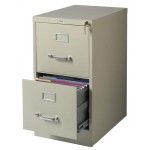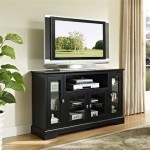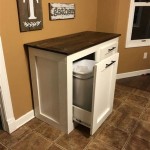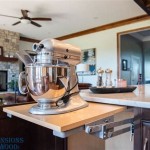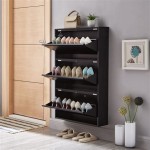Cabinet Doors: Inset Vs. Overlay
The selection of cabinet door styles is a principal decision in any kitchen or bathroom renovation or new construction project. Among the numerous options available, inset and overlay cabinet doors are two of the most prevalent. Each style presents distinct aesthetic and functional characteristics, influencing the overall appearance and usability of the cabinetry.
Inset cabinet doors, as the name implies, are designed to fit flush within the cabinet frame. The door sits inside the frame opening, creating a smooth, seamless appearance. Overlay cabinet doors, conversely, rest on top of the cabinet frame, partially or fully covering it. Understanding the nuances of each style is crucial for selecting the most suitable option for a particular project, considering factors such as desired aesthetic, budget, and functional requirements.
Aesthetic Differences
The primary distinction between inset and overlay cabinet doors lies in their visual impact. Inset cabinets offer a traditional, refined aesthetic. The flush alignment of the door with the frame creates clean, unbroken lines, contributing to a sense of formality and elegance. This style is often favored in classic, transitional, or farmhouse-style kitchens.
Overlay cabinets, on the other hand, present a more contemporary or transitional appearance. The visible cabinet frame can be incorporated as part of the design, adding visual interest and texture. The degree of overlay can vary, ranging from partial overlay, where a portion of the frame remains visible, to full overlay, where the doors and drawer fronts completely conceal the frame. Full overlay cabinets create a sleek, modern look with minimal visible gaps. The choice between partial and full overlay influences the overall aesthetic and the amount of storage space available within the cabinets.
The hardware selection also plays a significant role in the overall aesthetic. Inset cabinets often utilize more decorative hinges and latches, which are exposed and contribute to the traditional charm. Overlay cabinets, typically using concealed hinges, allow the hardware to be less prominent, creating a cleaner, more minimalist look. The chosen hardware can either complement or contrast with the cabinet style, further customizing the aesthetic.
Functional Considerations
Beyond aesthetics, inset and overlay cabinet doors offer differing functional characteristics. Inset cabinets, due to the door fitting within the frame, generally offer slightly less interior storage space compared to overlay cabinets. The frame itself occupies some of the interior volume. This difference, while often minimal, can be a factor in smaller kitchens or bathrooms where maximizing storage is paramount.
Overlay cabinets typically provide easier access to the cabinet interior. The doors open without obstruction from the frame, allowing for wider drawers and pull-out shelves. This accessibility can be particularly beneficial for individuals with limited mobility or those seeking to optimize the functionality of their kitchen.
The construction and installation processes also differ significantly. Inset cabinets require precise measurements and installation to ensure a perfectly flush fit. Any slight deviation in the frame or doors can result in gaps or misalignment, impacting the aesthetic and functionality. This precision translates to a more labor-intensive and potentially more expensive installation process. Overlay cabinets, with their forgiving nature, allow for slightly more flexibility in installation. Minor imperfections in the frame are less noticeable, making them a more practical option for projects with budget constraints or DIY installations. The complexity of hardware installation also differs; inset cabinets often require specialized hardware and expertise.
Durability and maintenance are also relevant factors. Inset cabinets, with their intricate construction and close tolerances, may be more susceptible to warping or damage due to humidity changes or temperature fluctuations. Maintaining a consistent indoor climate is crucial for preserving the integrity of inset cabinetry. Overlay cabinets, with their simpler construction and larger tolerances, are generally more resistant to environmental factors. The exposed frame of overlay cabinets can also offer additional protection to the door edges, reducing the likelihood of chipping or damage.
The cost implications for inset and overlay cabinets can vary considerably. Inset cabinets, due to their complex construction, precise installation requirements, and potentially specialized hardware, generally carry a higher price tag than overlay cabinets. The increased labor involved in manufacturing and installing inset cabinets contributes significantly to the overall cost. Overlay cabinets, with their simpler design and easier installation, are typically more budget-friendly. The availability of various overlay styles and materials also provides more flexibility in controlling costs.
Material and Style Versatility
Both inset and overlay cabinet doors are available in a wide range of materials, including wood, laminate, thermofoil, and metal. The material selection influences not only the aesthetic but also the durability, maintenance requirements, and cost of the cabinetry. Wood cabinets, whether inset or overlay, offer a timeless, natural look and can be stained or painted to match any décor. Laminate and thermofoil cabinets provide a more durable and cost-effective alternative to wood, offering resistance to scratches, stains, and moisture. Metal cabinets, typically used in modern or industrial settings, offer a sleek, contemporary look and are highly durable and easy to clean.
The style versatility of inset and overlay cabinets is also notable. Inset cabinets, while often associated with traditional styles, can be adapted to contemporary designs with the use of minimalist hardware and streamlined door profiles. Overlay cabinets, with their range of overlay options and door styles, can seamlessly blend into a variety of design aesthetics, from farmhouse to modern to transitional. The choice of door style, such as Shaker, raised panel, or slab, further customizes the cabinetry and complements the overall design of the space.
The choice between inset and overlay cabinets often depends on the specific design goals and budgetary constraints of a project. Inset cabinets offer a sophisticated, high-end look but require a significant investment. Overlay cabinets provide a more affordable and versatile option, allowing for customization and adaptation to various design styles. Understanding the strengths and limitations of each style is crucial for making an informed decision that aligns with the desired aesthetic, functional requirements, and budget.
The hardware selected for cabinet doors significantly impacts the function and look of the cabinets. Inset cabinets frequently feature visible hinges, which can serve as an accent. These hinges often come in antique or decorative styles, adding to the traditional aesthetic. Overlay cabinets typically use concealed hinges, which are hidden from view when the door is closed, creating a cleaner, more modern appearance. The type of knob or pull chosen can also influence the overall style, with options ranging from simple and sleek to ornate and decorative.
Lighting can highlight the differences between inset and overlay cabinet doors. Under-cabinet lighting accentuates the lines and details of inset cabinets, emphasizing their craftsmanship. In overlay cabinets, lighting can highlight the visible frame or the doors themselves, creating a layered and dimensional effect. Properly planned lighting can enhance the aesthetic appeal of either cabinet style, adding depth and visual interest to the space.
Ultimately, the selection of cabinet doors depends heavily on personal preference, the existing architectural style of the space, and the desired overall ambiance. Consulting with a kitchen or bathroom designer can provide valuable insights and guidance in making the optimal choice. These professionals can assess the specific needs of the client, offer design recommendations, and assist in selecting the materials, hardware, and finishes that best complement the chosen cabinet style.

Overlay Vs Inset In Kitchen And Bath Remodels

What Is Cabinet Door Overlay Woodworker Express

Shaker Kitchen Cabinet Inset Or Overlay

Overlay Vs Inset In Kitchen And Bath Remodels

Inset Vs Overlay Cabinets Ultimate Guide For Smart Choices 2025

Inset Vs Overlay Cabinets Which Style Suits Your Kitchen

Inset Vs Overlay Cabinets Which Type Is Right For You

Faqs 2 Hanson Custom Builders

Inset Vs Overlay Cabinets Pa Kitchen

How To Determine Cabinet Door Size Beginner S Guide

